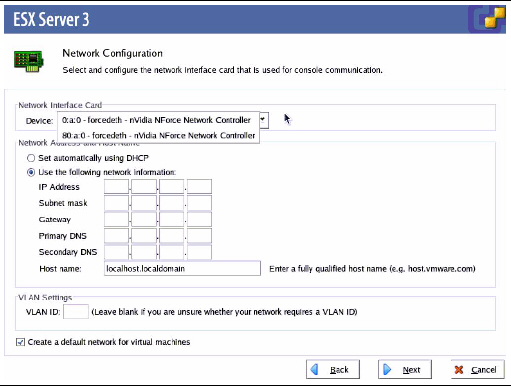| C H A P T E R 7 |
|
Installing VMware |
This chapter contains information about installing a VMware ESX Server 4 OS on a Sun Fire X4140, X4240, or X4440 server.
| Note - If you want to mirror your OS, the recommended procedure is to create a hardware RAID before you install the OS. |
Review the following sections:
The following table maps out the installation task order and points to the relevant section where you can find more information.
Before you begin installing VMware ESX Server 3 software on a Sun Fire X4140, X4240, or X4440 server, collect the necessary information pertinent to your situation by consulting the following required documents at:
http://www.vmware.com/ support/pubs/vi_pubs.html
Refer to the Sun Fire X4140, X4240, and X4440 Servers Service Manual for detailed information concerning network interface cabling and the BIOS considerations of these interfaces.
The most common methods to install VMware on your server are to use:
This chapter contains the procedures for the first three methods. For information about preparing for PXE install, see the VMware Installation and Upgrade Guide for VESX Server 3 and Virtual Center 2.0, Chapter 6, “Remote and Scripted Installations” at http://www.vmware.com/ support/pubs/vi_pubs.html.
http://www.vmware.com/support/pubs/vi_pubs.html.
No matter what method you choose to install VMWare ESX Server, you must first download an ISO image of the software installation CD.
|
1. Download the ISO image using a network-connected system with CD-burning capabilities from:
http://www.vmware.com/download/vi/eval.html
2. Optionally, burn the image to a CD.
This section explains how to install the VMWare ESX OS on your server using the Integrated Lights Out Manager (ILOM) Remote Console application.
|
1. Locate your VMWare ESX Server installation CD/DVD or the equivalent ISO image.
2. Connect to the ILOM Service Processor Web interface.
3. Click the Remote Control tab, then the Mouse Mode Settings tab.
4. If necessary, change the mouse mode to Relative Mouse Mode.
See the “Remote Console Application” chapter of the Integrated Lights Out Manager (ILOM) Administration Guide for further instructions.
6. Click the Launch Redirection button to start the JavaRConsole application.
7. Log in to the JavaRConsole.
8. Start keyboard and mouse redirection.
Select Keyboard and Mouse in the Devices menu.
From the JavaRConsole Devices menu, you can redirect the CD in two ways:
10. Refer to the Installation and Upgrade Guide for VMware Infrastructure to guide you through the installation process.
From your network-connected system go to:
http://www.vmware.com/support/pubs/vi_pubs.html.
11. Identify the specific network interface.
In the service console window on the Sun Fire X4140, X4240, or X4440 server, identify the available network configuration alternatives (see FIGURE 7-1).
|
1. Connect a USB Keyboard and Mouse to the USB ports on the server.
2. Connect a monitor to the server.
4. Insert the media into the server’s CD/DVD drive. The server will boot from the CD/DVD and display a boot prompt:
5. To access the graphical mode, press Enter.
6. To work in text mode, enter the following:
7. Refer to the Installation and Upgrade Guide for VMware Infrastructure to guide you through the installation process.
From your network-connected system go to:
http://www.vmware.com/support/pubs/vi_pubs.html.
8. Identify the specific network interface.
In the service console window on the Sun Fire X4140, X4240, or X4440 server, identify the available network configuration alternatives (see FIGURE 7-1). The listing may differ depending on the NICs installed in your server.
FIGURE 7-1 ESX Server 3 Network Configuration Dialog Box

9. Complete the VMware installation.
This is detailed in the Installation and Upgrade Guide for VMware Infrastructure at:
http://www.vmware.com/support/pubs/vi_pubs.html.
VMware ESX Server 3 update images are available for download at:
http://www.vmware.com/selfsupport/download
Copyright © 2009 Sun Microsystems, Inc. All rights reserved.